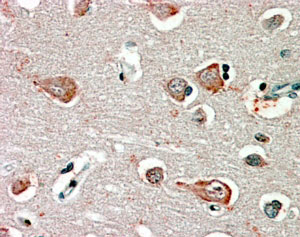GABRB3 Antibody (internal region)
Peptide-affinity purified goat antibody
- SPECIFICATION
- CITATIONS
- PROTOCOLS
- BACKGROUND

Application
| IHC, E |
|---|---|
| Primary Accession | P28472 |
| Other Accession | NP_000805.1, NP_068712.1, 2562, 14402 (mouse), 24922 (rat) |
| Reactivity | Human |
| Predicted | Mouse, Rat, Dog |
| Host | Goat |
| Clonality | Polyclonal |
| Concentration | 0.5 mg/ml |
| Isotype | IgG |
| Calculated MW | 54116 Da |
| Gene ID | 2562 |
|---|---|
| Other Names | Gamma-aminobutyric acid receptor subunit beta-3, GABA(A) receptor subunit beta-3, GABRB3 |
| Dilution | IHC~~1:100~500 E~~N/A |
| Format | 0.5 mg/ml in Tris saline, 0.02% sodium azide, pH7.3 with 0.5% bovine serum albumin |
| Storage | Maintain refrigerated at 2-8°C for up to 6 months. For long term storage store at -20°C in small aliquots to prevent freeze-thaw cycles. |
| Precautions | GABRB3 Antibody (internal region) is for research use only and not for use in diagnostic or therapeutic procedures. |
| Name | GABRB3 (HGNC:4083) |
|---|---|
| Function | Beta subunit of the heteropentameric ligand-gated chloride channel gated by gamma-aminobutyric acid (GABA), a major inhibitory neurotransmitter in the brain (PubMed:14993607, PubMed:18514161, PubMed:22243422, PubMed:22303015, PubMed:24909990, PubMed:26950270, PubMed:30602789). GABA-gated chloride channels, also named GABA(A) receptors (GABAAR), consist of five subunits arranged around a central pore and contain GABA active binding site(s) located at the alpha and beta subunit interface(s) (PubMed:24909990, PubMed:30140029, PubMed:30602789). GABAARs containing beta-3/GABRB3 subunit are found at both synaptic and extrasynaptic sites (By similarity). When activated by GABA, GABAARs selectively allow the flow of chloride anions across the cell membrane down their electrochemical gradient (PubMed:14993607, PubMed:22303015, PubMed:26950270, PubMed:30602789). Chloride influx into the postsynaptic neuron following GABAAR opening decreases the neuron ability to generate a new action potential, thereby reducing nerve transmission (PubMed:22303015, PubMed:26950270). GABAARs containing alpha-1 and beta-3 subunits exhibit synaptogenic activity; the gamma-2 subunit being necessary but not sufficient to induce rapid synaptic contacts formation (PubMed:25489750). Extrasynaptic beta-3 receptors contribute to the tonic GABAergic inhibition (By similarity). GABAARs containing alpha-1, beta-3 and epsilon subunits may also permit spontaneous chloride channel activity while preserving the structural information required for GABA-gated openings (By similarity). Beta- containing GABAARs can simultaneously bind GABA and histamine where histamine binds at the interface of two neighboring beta subunits, which may be involved in the regulation of sleep and wakefulness (PubMed:18281286, PubMed:24909990, PubMed:35355020). Plays an important role in somatosensation and in the production of antinociception (By similarity). |
| Cellular Location | Postsynaptic cell membrane; Multi-pass membrane protein {ECO:0000269|PubMed:24909990, ECO:0000269|PubMed:35355020, ECO:0007744|PDB:7QN7}. Cell membrane; Multi-pass membrane protein {ECO:0000269|PubMed:24909990, ECO:0000269|PubMed:35355020, ECO:0007744|PDB:7QN7}. Cytoplasmic vesicle membrane {ECO:0000250|UniProtKB:P63079} |

Thousands of laboratories across the world have published research that depended on the performance of antibodies from Abcepta to advance their research. Check out links to articles that cite our products in major peer-reviewed journals, organized by research category.
info@abcepta.com, and receive a free "I Love Antibodies" mug.
Provided below are standard protocols that you may find useful for product applications.
Background
This antibody is expected to recognize both reported isoforms (NP_000805.1, NP_068712.1).
References
Hyperglycosylation and reduced GABA currents of mutated GABRB3 polypeptide in remitting childhood absence epilepsy. Tanaka M, Olsen RW, Medina MT, Schwartz E, Alonso ME, Duron RM, Castro-Ortega R, Martinez-Juarez IE, Pascual-Castroviejo I, Machado-Salas J, Silva R, Bailey JN, Bai D, Ochoa A, Jara-Prado A, Pineda G, Macdonald RL, Delgado-Escueta AV. Am. J. Hum. Genet. 2008 Jun 82 (6): 1249-61. PMID: 18514161
If you have used an Abcepta product and would like to share how it has performed, please click on the "Submit Review" button and provide the requested information. Our staff will examine and post your review and contact you if needed.
If you have any additional inquiries please email technical services at tech@abcepta.com.













 Foundational characteristics of cancer include proliferation, angiogenesis, migration, evasion of apoptosis, and cellular immortality. Find key markers for these cellular processes and antibodies to detect them.
Foundational characteristics of cancer include proliferation, angiogenesis, migration, evasion of apoptosis, and cellular immortality. Find key markers for these cellular processes and antibodies to detect them. The SUMOplot™ Analysis Program predicts and scores sumoylation sites in your protein. SUMOylation is a post-translational modification involved in various cellular processes, such as nuclear-cytosolic transport, transcriptional regulation, apoptosis, protein stability, response to stress, and progression through the cell cycle.
The SUMOplot™ Analysis Program predicts and scores sumoylation sites in your protein. SUMOylation is a post-translational modification involved in various cellular processes, such as nuclear-cytosolic transport, transcriptional regulation, apoptosis, protein stability, response to stress, and progression through the cell cycle. The Autophagy Receptor Motif Plotter predicts and scores autophagy receptor binding sites in your protein. Identifying proteins connected to this pathway is critical to understanding the role of autophagy in physiological as well as pathological processes such as development, differentiation, neurodegenerative diseases, stress, infection, and cancer.
The Autophagy Receptor Motif Plotter predicts and scores autophagy receptor binding sites in your protein. Identifying proteins connected to this pathway is critical to understanding the role of autophagy in physiological as well as pathological processes such as development, differentiation, neurodegenerative diseases, stress, infection, and cancer.


